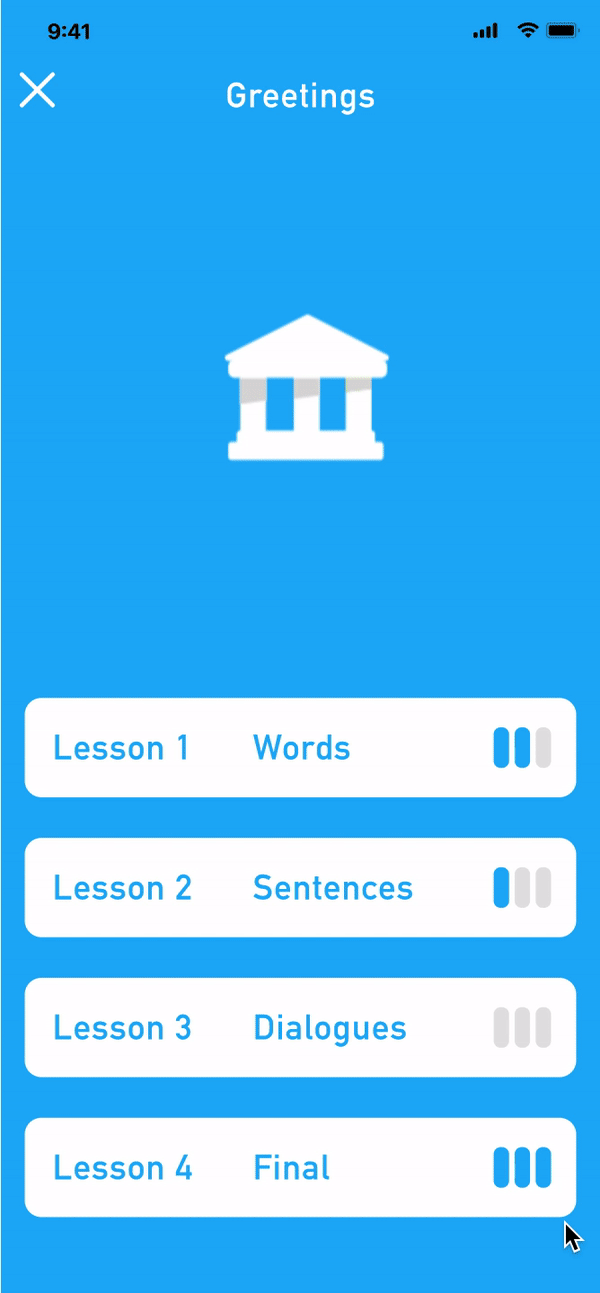Duolingo's feature aides learners in speaking lessons
DuoSpeak provides speaking lessons, aiding learners in language comprehension with confidence as well as increasing engagement with Duolingo’s application.

Challenge
This is an individual project inspired from Duolingo application. As a second-language learner, I learned a lot using Duolingo, but also think that there are space for improvement for Duolingo.
How might we design a pronunciation assistance feature allowing students to improve their speaking skills and assess their pronunciation mistakes?
RESEARCH
Understanding the needs of Second Language-Learners
To be fluent in a language, students have to improve 4 foundational skills: reading, writing, listening, and speaking. When working with an already-established application, I often look for its user reviews in App Store, Android Play Store, and its forum community. This exercise was a great start because it allows a greater access to observing a large number of users’ pain points.

Then, I spoke with users who have experience with Duolingo for a deeper understanding about how Duolingo can improve on language-learner comprehensibility. Realizing different languages have their unique challenges, I set up interviews with 5 students who have used Duolingo to learn second and third-languages.
2️⃣ interviews with students learning Chinese
1️⃣ interview with a student learning Japanese
1️⃣ interview with a student learning French
1️⃣ interview with a student learning Vietnamese
Driving insights and takeaways
Limited feedbacks on speakers’ prosody quality in words and sentences
With limited feedback from the online language platforms, students have a difficult time hearing their own pronunciation mistakes, leading to communication and comprehension difficulties for the students.
Speech anxiety due to bad pronunciations/accents
International students are anxious in communicating to native speakers.
PROCESS
To translate research results into design solutions faster, I applied the Goal-Directed Design method, which I learnt about through research. I then organized my research points to visualize my collected insights.
Defining learner’s speaking goals
I investigated how learners perceive pronunciation and their goals in reducing their accent in language pronunciation to achieve a pronunciation that is indistinguishable from native speakers.

Identifying frictions and opportunities
From this I was able to identify clear pain points and frictions students felt when connecting with others, and on the platform as a whole. By answering How Might We questions, I can convert frictions to opportunities that are applicable to the final solution’s features.

Ideating solutions
💬 Personalized Feedback
With the individualized instruction, students can spend more time on their areas of weakness, and get feedback on their specific utterances instead of feedback which attempts to address generic mistakes.
🔊 Mimicking Model Speakers
Practicing one chosen sound and recording it, comparing the sound and waveform of their own voice with those of the native speaker and practicing selected words and sentences.
📱 Visual Displays for Pronunciation Mistakes
It shows specific sounds and the correct percentage that learners struggle.

Project goals
Primary persona
To uncover my research about student behaviors, goals, needs, or frustration, I created a persona to get a holistic view of my solution.

Language Learners' Journey Map
By looking at the big picture to see the full journey of users using Duolingo, then navigating to DuoSpeak as part of their features, I implemented DuoSpeak after users learn the vocabulary section, which allows them to practice speaking words they have recently learned. By perfecting their speaking and memorization of new words, users feel more comfortable practicing listening because they can visualize the words by the correct sounds/pronunciation.

Solution
Sketches
Before finalizing my concept, I gathered all features to keep track in my sketch and see how those features can be applied to the prototype. I then explored through quick pen-and-paper sketches to visualize the form and understand how users would move through the experience.

Interactive Prototype
For my learning progress, I aim to learn different design platforms to be able to differentiate functionalities among those platforms. I used Adobe XD for this project because it doesn't require too many micro interactions.
Get Instant Feedback
After recording your voice, the feature contains instant feedback and score percentage to identify misspelling vowels or words and grade your pronunciation. Users can browse through selected tutorial videos to improve your speaking.

Tailored dialogue practices
As part of maturing learner's speaking skills, I want to provide the option to advance their learning from words to dialogues. The feature helps users by practicing conversation with different themes or topics.

💬 After thought
System design thinking when building within an existing application
When working on an existing application, it's essential for designers to understand the app thoroughly, including its visual design or interaction patterns, or even its content design. Although I worked on this feature for 2 weeks, I spent the majority of my time understanding Duolingo in and out from brand identity, to brand narrative, to successfully represent Duolingo with core brand elements and consistent contents across all mediums.
Given more time, I think it would be necessary to explore different patterns of prosody from different languages to update how users can improve their speaking skills. I believe additional consideration towards how DuoSpeak my avoid duplication in tasks that already exist in Duolingo will completely revamp the learner’s learning process.
